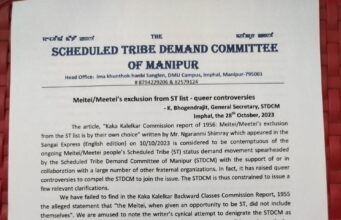 The Hmar tribe is one of the scheduled tribe of Manipur belonging to Kuki-Chin-Mizo group. They are concentrated in Tipaimukh and Churachandpur sub-divisions of Churachandpur district.
The Hmar tribe is one of the scheduled tribe of Manipur belonging to Kuki-Chin-Mizo group. They are concentrated in Tipaimukh and Churachandpur sub-divisions of Churachandpur district.- According to the Census of 2001, the population of Hmar tribe is 42690 as compared to 36092 in the Census of 1991.
- The word “Hmar” means north and by extension the “Northerners” as the Hmar have a geographical diretion to the north of the Mizo. Their myth stated that they emerged out of a cave or hole-what they called Sinlung-in common with their cognate tribes. Their folk songs retold through generations about the exodus from a cave.
- Almost the entire population of Hmar tribe can be classified as agriculturalist, blacksmiths and professional priests. Women are good weavers. They practise both dry and wet cultivation.
- As regards the Hmar society, the patriarchal family forms the smallest and basic units. Ideally, joint family syatem is peculiar to them but in reality, at present, nuclear family of medium size i.e, 4-6 individuals a family, is the dominant type. The tribe includes clans and sub-clans and families. The exact number of clans is not fully understood by one and all and there is confusion regarding the clan number. In marriage the Hmar is not restricted to any particular clan or family. He can marry any woman except his sister, aunt, mother and grandmother. There are very instances of polygamy among the Hmars. The bride price is divided among several members of the family of which the bride’s father gets the major share. The matrimonial bond is extremely loose and divorce can be inititated by either of the spouse without any proper reason. Marriage is arranged with the consent of the mates. Ultimogeniture is the rule of inheritance.
- The village administration of the Hmar people consists of Lal (Chief), Khawnbawl upa (chief minister), Khonbols (ministers) and the people from whom on is chosen to become the Khawnbawl upa. The land is common property of the people and the chief and ministers are trustees with the power to see to the rightful use and distribution to each homestead for cultivation. The chief presides over the village council and they discuss and decide all matters including civil and criminal cases.
- The Hmars have followed Christianity and the adoption is said to be from 1910. Before Christianity, the Hmars believe in the existence of God called Pathian, the creator.
- The traditional festivals of Hmar include Siel-sun (sacrificial festival of the wild animals a man had killed in hunting and war), In-ching (highly valued old festival), Buinei (celebration by rich man), Khongchoi, Butukhonglom (agricultural festival), Lomjii, and Chavang Kut (post-harvest festival).
- Traditionally, a Hmar man wears a tunic like shirt and loin cloth of 5×2 sq. feet in dimension. A woman wears an inner petticoat fastened with a string at the waist. Over it she wears a tunic type of blouse. The Hmar uses variant outer clothes for specific occasions. For instance, a Hmar woman puts on Hmar-am or Kenbuongthuom at gala times and as dance costume; Puanlaisen as ordinary skirt; Hmar-puan at festive occasions; Ngoutekher is worn during marriage ceremonies by the close friends and relatives of the bride; Mithipuon is the dress of death ritual.











